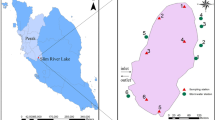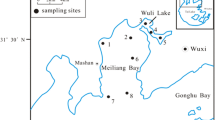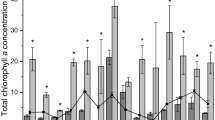Abstract
The role of nutrient loading on biomass growth in wastewater-impacted rivers is important in order to effectively optimize wastewater treatment to avoid excessive biomass growth in the receiving water body. This paper directly relates wastewater treatment plant (WWTP) effluent nutrients (including ammonia (NH3-N), nitrate (NO3-N) and total phosphorus (TP)) to the temporal and spatial distribution of epilithic algae and macrophyte biomass in an oligotrophic river. Annual macrophyte biomass, epilithic algae data and WWTP effluent nutrient data from 1980 to 2012 were statistically analysed. Because discharge can affect aquatic biomass growth, locally weighted scatterplot smoothing (LOWESS) was used to remove the influence of river discharge from the aquatic biomass (macrophytes and algae) data before further analysis was conducted. The results from LOWESS indicated that aquatic biomass did not increase beyond site-specific threshold discharge values in the river. The LOWESS-estimated biomass residuals showed a variable response to different nutrients. Macrophyte biomass residuals showed a decreasing trend concurrent with enhanced nutrient removal at the WWTP and decreased effluent P loading, whereas epilithic algae biomass residuals showed greater response to enhanced N removal. Correlation analysis between effluent nutrient concentrations and the biomass residuals (both epilithic algae and macrophytes) suggested that aquatic biomass is nitrogen limited, especially by NH3-N, at most sampling sites. The response of aquatic biomass residuals to effluent nutrient concentrations did not change with increasing distance to the WWTP but was different for P and N, allowing for additional conclusions about nutrient limitation in specific river reaches. The data further showed that the mixing process between the effluent and the river has an influence on the spatial distribution of biomass growth.








Similar content being viewed by others
References
AEP (2006). Aquatic Ecosystems Field Sampling Protocols. ISBN: 0–7785–5079-6. Retrieved from http://esrd.alberta.ca/water/programs-and-services/surface-water-quality-program/documents/AquaticEcosystemsFieldSampling-Mar2006.pdf
Anderson, E. L., Welch, E. B., Jacoby, J. M., Schimek, G. M., & Horner, R. R. (1999). Periphyton removal related to phosphorus and grazer biomass level. Freshwater Biology, 41(3), 633–651. doi:10.1046/j.1365-2427.1999.00405.x.
Askey, P. J., Hogberg, L. K., Post, J. R., Jackson, L. J., Rhodes, T., & Thompson, M. S. (2007). Spatial patterns in fish biomass and relative trophic level abundance in a wastewater enriched river. Ecology of Freshwater Fish, 16(3), 343–353. doi:10.1111/j.1600-0633.2007.00221.x.
Barko, J. W., Gunnison, D., & Carpenter, S. R. (1991). Sediment interactions with submersed macrophyte growth and community dynamics. Aquatic Botany, 41(1–3), 41–65. doi:10.1016/0304-3770(91)90038-7.
Barko, J. W., Hardin, D. G., & Matthews, M. S. (1982). Growth and morphology of submersed freshwater macrophytes in relation to light and temperature. Canadian Journal of Botany, 60(6), 877–887. doi:10.1139/b82-113.
Biggs, B. J. F., & Close, M. E. (1989). Periphyton biomass dynamics in gravel bed rivers: the relative effects of flows and nutrients. Freshwater Biology, 22, 209–231.
Bodo, B. A. (1992). Statistical analysis of regional surface water quality in southeastern Ontario. Environmental Monitoring and Assessment, 23, 165–187.
Bornette, G., & Puijalon, S. (2011). Response of aquatic plants to abiotic factors: a review. Aquatic Sciences, 73, 1–14. doi:10.1007/s00027-010-0162-7.
Bothwell, M. L. (1989). Phosphorus-limited growth dynamics of lotic periphyton diatom communities: areal biomass and cellular growth rate responses. Canadian Journal of Fisheries and Aquatic Sciences, 46, 1293–1301.
Bowman, M. F., Chambers, P. A., & Schindler, D. W. (2005). Epilithic algal abundance in relation to anthropogenic changes in phosphorus availability and limitation in mountain rivers. Canadian Journal of Fisheries and Aquatic Sciences, 62(1), 174–184.
Bowman, M. F., Chambers, P. A., & Schindler, D. W. (2007). Constraints on benthic algal response to nutrient addition in oligothrophic mountain rivers. River Research and Applications, 23, 858–876. doi:10.1002/rra.
Carr, G. M., & Chambers, P. A. (1998). Macrophyte growth and sediment phosphorus and nitrogen in a Canadian prairie river. Freshwater Biology, 39, 525–536.
Chambers, P. A., & Prepas, E. E. (1994). Nutrient dynamics in riverbeds: the impact of sewage effluent and aquatic macrophytes. Water Research, 28(2), 453–464.
Chambers, P. A., Prepas, E. E., Bothwell, M. L., & Hamilton, H. R. (1989). Roots versus shoots in nutrient uptake by aquatic macrophytes in flowing waters. Canadian Journal of Fisheries and Aquatic Sciences, 46, 435–439.
Chambers, P. A., Prepas, E. E., Hamilton, H. R., & Bothwell, M. L. (1991). Current velocity and its effect on aquatic macrophytes in flowing waters. Ecological Applications, 1(3), 249–257.
Chung, C.W.Y (2013). Diel oxygen cycles in the Bow River: Relationships to Calgary’s urban footprint and periphyton and macrophyte biomass (Master’s thesis). Retrieved from ProQuest Dissertations & Thesis @ University of Calgary.
Cleveland, W. S. (1979). Robust locally and smoothing weighted regression scatterplots. Journal of the American Statistical Association, 74(368), 829–836.
Cross, P.M., Hamilton, H.R. Charlton, S.E.D. 1986. The limnological characteristics of the Bow, Oldman and South Saskatchewan rivers (1979–82). Part I. Nutrient and water chemistry. Pollution Control Division, Alberta Environment, Edmonton, Alta. Available from Alberta Government Library.
Denny, P. (1972). Sites of nutrient absorption in aquatic macrophytes. Journal of Ecology, 60(3), 819–829.
Elser, J. J., Bracken, M. E. S., Cleland, E. E., Gruner, D. S., Harpole, W. S., Hillebrand, H., … Smith, J. E. (2007). Global analysis of nitrogen and phosphorus limitation of primary producers in freshwater, marine and terrestrial ecosystems. Ecology Letters, 10(12), 1135–42. 10.1111/j.1461-0248.2007.01113.x
Elser, J. J., Marzolf, E. R., & Goldman, C. R. (1990). Phosphorus and nitrogen limitation of Phytop ankton growth in the freshwaters of North America : a review and critique of experimental enrichments. Canadian Journal of Fisheries and Aquatic Sciences, 47, 1468–1477.
Franklin, P., Dunbar, M., & Whitehead, P. (2008). Flow controls on lowland river macrophytes: a review. Science of the Total Environment, 400, 369–378.
Gücker, B., Brauns, M., & Pusch, M. T. (2006). Effects of wastewater treatment plant discharge on ecosystem structure and function of lowland streams. Journal of the North American Benthological Society, 25(2), 313–329.
He, J., Chu, A., Ryan, M. C., Valeo, C., & Zaitlin, B. (2011). Abiotic influences on dissolved oxygen in a riverine environment. Ecological Engineering, 37(11), 1804–1814. doi:10.1016/j.ecoleng.2011.06.022.
Hecky, R. E., & Kilham, P. (1988). Nutrient limitation of phytoplankton in freshwater and marine environments : a review of recent evidence on the effects of enrichment. Limnology and Oceanography, 33(4), 796–822.
Helsel, D. R. Hirsch, R. M (1992). Chapter A3—statistical methods in water resources. In Techniques of Water-Resources Investigations of the USGS, Book 4, Hydrologic Analysis and Interpretation.
Hill, W. R., Boston, H. L., & Steinman, A. D. (1992). Grazers and nutrients simultaneously limit lotic primary productivity. Canadian Journal of Fisheries and Aquatic Sciences, 49, 504–512.
Hoellein, T. J., Arango, C. P., & Zak, Y. (2011). Spatial variability in nutrient concentration and biofilm nutrient limitation in an urban watershed. Biogeochemistry, 106(2), 265–280. doi:10.1007/s10533-011-9631-x.
Hogberg, L.K (2004). A chemical, biological, and isotopic analysis of the spatial extent of wastewater effluent on rivers in southern Alberta, Canada (Master’s thesis). Retrieved from ProQuest Dissertations & Thesis @ University of Calgary. UMI Dissertations Publishing, 2004. MQ97653.
Iwanyshyn, M., Ryan, M. C., & Chu, A. (2008). Separation of physical loading from photosynthesis/respiration processes in rivers by mass balance. The Science of the Total Environment, 390(1), 205–214. doi:10.1016/j.scitotenv.2007.09.038.
Jacoby, W. G. (2000). Loess : a nonparametric, graphical tool for depicting relationships between variables. Electoral Studies, 19, 577–613.
Lee, H. W., Bhang, K. J., & Park, S. S. (2010). Effective visualization for the spatiotemporal trend analysis of the water quality in the Nakdong River of Korea. Ecological Informatics, 5, 281–292. doi:10.1016/j.ecoinf.2010.05.004.
Lewis, W. M., & Wurtsbaugh, W. A. (2008). Control of lacustrine phytoplankton by nutrients: erosion of the phosphorus paradigm. International Review of Hydrobiology, 93(4–5), 446–465. doi:10.1002/iroh.200811065.
Martín-Benito, D., Gea-Izquierdo, G., del Río, M., & Cañellas, I. (2008). Long-term trends in dominant-height growth of black pine using dynamic models. Forest Ecology and Management, 256, 1230–1238. doi:10.1016/j.foreco.2008.06.024.
McCauley, E., Downing, J. A., & Watson, S. (1989). Sigmoid relationships between nutrients and chlorophyll among lakes. Canadian Journal of Fisheries and Aquatic Sciences, 46, 1171–1175. doi:10.1139/f89-152.
Nimick, D. A., Gammons, C. H., & Parker, S. R. (2011). Diel biogeochemical processes and their effect on the aqueous chemistry of streams: a review. Chemical Geology, 283, 3–17. doi:10.1016/j.chemgeo.2010.08.017.
Pearsall, W. H. (1921). The development of vegetation in the English Lakes, considered in relation to the general evolution of Glacial Lakes and rock basins. Proceedings of the Royal Society of London. Series B, Containing Papers of a Biological Character, 92(647), 259–284.
Rattray, M. R., Howard-Williams, C., & Brown, J. M. A. (1991). Sediment and water as sources of nitrogen and phosphorus for submerged rooted aquatic macrophytes. Aquatic Botany, 40(3), 225–237. doi:10.1016/0304-3770(91)90060-I.
Riis, T., & Biggs, B. J. F. (2003). Hydrologic and hydraulic control of macrophyte establishment and performance in streams. Limnology and Oceanography, 48(4), 1488–1497.
Robinson, K. L., Valeo, C., Ryan, M. C., Chu, A., & Iwanyshyn, M. (2009). Modelling aquatic vegetation and dissolved oxygen after a flood event in the Bow River, Alberta, Canada. Canadian Journal of Civil Engineering, 36, 492–503.
Robson, A. J., & Neal, C. (1996). Water quality trends at an upland site in Wales, UK, 1983-1993. Hydrological Processes, 10, 183–203.
Rozemeijer, J. C., Klein, J., Broers, H. P., van Tol-Leenders, T. P., & van der Grift, B. (2014). Water quality status and trends in agriculture-dominated headwaters: a national monitoring network for assessing the effectiveness of national and European manure legislation in the Netherlands. Environmental Monitoring and Assessment, 186(12), 8981–8995. doi:10.1007/s10661-014-4059-0.
Sanderson, B. L., Coe, H. J., Tran, C. D., Macneale, K. H., Harstad, D. L., & Goodwin, A. B. (2009). Nutrient limitation of periphyton in Idaho streams: results from nutrient diffusing substrate experiments. Journal of the North American Benthological Society, 28(4), 832–845. doi:10.1899/09-072.1.
Sand-Jensen, K. (1989). Environmental variables and their effect on photosynthesis of aquatic plant communities. Aquatic Botany, 34(1–3), 5–25. doi:10.1016/0304-3770(89)90048-X.
Sosiak, A. (2002). Long-term response of periphyton and macrophytes to reduced municipal nutrient loading to the Bow River ( Alberta, Canada ). Canadian Journal of Fisheries and Aquatic Sciences, 59, 987–1001. doi:10.1139/F02-071.
Stevenson, R. J., Bothwell, M. L., & Lowe, R. L. (1996). Algal ecology: freshwater benthic ecosystems (pp. 321–340). USA: Elsevier.
Vandenberg, J. a., Ryan, M. C., Nuell, D. D., & Chu, A. (2005). Field evaluation of mixing length and attenuation of nutrients and fecal coliform in a wastewater effluent plume. Environmental Monitoring and Assessment, 107(1–3), 45–57. doi:10.1007/s10661-005-2020-y.
Vandenberg, J. A (2004). Water Quality of the Bow River downstream of Calgary, Alberta (Master’s thesis). Retreived from ProQuest Dissertations & Thesis @ University of Calgary. UMI Dissertations Publishing 2004. MQ97547.
Waiser, M. J., Tumber, V., & Holm, J. (2011). Effluent-dominated streams. Part 1: presence and effects of excess nitrogen and phosphorus in Wascana Creek, Saskatchewan, Canada. Environmental Toxicology and Chemistry, 30(2), 496–507. doi:10.1002/etc.399.
Wassenaar, L. I., Venkiteswaran, J. J., Schiff, S. L., & Koehler, G. (2010). Aquatic community metabolism response to municipal effluent inputs in rivers quantified using diel δ 18 O values of dissolved oxygen. Canadian Journal of Fisheries and Aquatic Sciences, 67, 1232–1246.
Wetzel, R.G 2001. Limnology 3rd edition. Elsevier Science (USA).
Wilson, A. W., Do, P., & Keller, W. E. (1998). Implementation of the biological nutrient removal program at Calgary’s Bonnybrook wastewater treatment plant. Water Science and Technology, 38(1), 47–54.
Wold, A. P., & Hershey, A. E. (1999). Spatial and temporal variability of nutrient limitation in 6 north shore tributaries to Lake superior. Journal of the North American Benthological Society, 18(1), 2–14 Retrieved from http://www.jstor.org/stable/1468005?seq=1#page_scan_tab_contents.
Acknowledgments
We thank all the technical and professional staff at the city of Calgary and Alberta Environment and Parks for providing the data. The Natural Science and Engineering Research Council of Canada Industrial Postgraduate Scholarship Program (NSERC IPS), in partnership with the city of Calgary, provided the funds to conduct this research which is greatly appreciated.
Author information
Authors and Affiliations
Corresponding author
Rights and permissions
About this article
Cite this article
Taube, N., He, J., Ryan, M.C. et al. Relative importance of P and N in macrophyte and epilithic algae biomass in a wastewater-impacted oligotrophic river. Environ Monit Assess 188, 494 (2016). https://doi.org/10.1007/s10661-016-5493-y
Received:
Accepted:
Published:
DOI: https://doi.org/10.1007/s10661-016-5493-y




